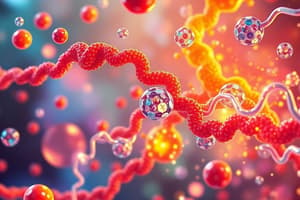Podcast
Questions and Answers
What is the primary role of proteins in living organisms?
What is the primary role of proteins in living organisms?
- Transporting oxygen in the blood
- Facilitating chemical reactions (correct)
- Storing genetic information
- Regulating body temperature
Carbohydrates consist of carbon, hydrogen, and sulfur.
Carbohydrates consist of carbon, hydrogen, and sulfur.
False (B)
What are the two main types of metabolism processes?
What are the two main types of metabolism processes?
Anabolic and catabolic
The basic building blocks of proteins are called ______.
The basic building blocks of proteins are called ______.
Match the following biological macromolecules with their functions:
Match the following biological macromolecules with their functions:
Which sugar is considered the primary energy source for cells?
Which sugar is considered the primary energy source for cells?
Enzymes operate efficiently under any temperature and pH conditions.
Enzymes operate efficiently under any temperature and pH conditions.
What is the structure of DNA?
What is the structure of DNA?
Lipids are primarily composed of ______ and glycerol.
Lipids are primarily composed of ______ and glycerol.
Which of the following hormones plays a crucial role in regulating metabolism?
Which of the following hormones plays a crucial role in regulating metabolism?
Flashcards
What is biochemistry?
What is biochemistry?
The study of chemical reactions that occur in living organisms, focusing on organic compounds and their roles in biological processes.
What are proteins?
What are proteins?
Large molecules made up of chains of amino acids linked by peptide bonds. They play crucial roles in enzymes, structural support, and transport. Their function depends on amino acid sequence and structure.
What are carbohydrates?
What are carbohydrates?
Organic compounds composed of carbon, hydrogen, and oxygen. They range from simple sugars like glucose to complex carbohydrates like starch. They are vital for energy storage and provision.
What are lipids?
What are lipids?
Signup and view all the flashcards
What are nucleic acids?
What are nucleic acids?
Signup and view all the flashcards
What is metabolism?
What is metabolism?
Signup and view all the flashcards
What are enzymes?
What are enzymes?
Signup and view all the flashcards
What are hormones?
What are hormones?
Signup and view all the flashcards
What is photosynthesis?
What is photosynthesis?
Signup and view all the flashcards
What is cellular respiration?
What is cellular respiration?
Signup and view all the flashcards
Study Notes
مقدمة في الكيمياء الحيوية
- الكيمياء الحيوية هي دراسة التفاعلات الكيميائية التي تحدث في الكائنات الحية.
- تركز هذه الدراسة على المركبات العضوية، وتفاعلاتها، ودورها في العمليات الحيوية.
- تشمل الكيمياء الحيوية دراسة البروتينات، والكربوهيدرات، والدهون، والأحماض النووية.
- تهدف الكيمياء الحيوية إلى فهم كيفية عمل الكائنات الحية على مستوى جزيئي.
المركبات العضوية الأساسية
-
البروتينات: تتكون البروتينات من سلاسل من الأحماض الأمينية المتصلة ببعضها بروابط ببتيدية.
-
تلعب البروتينات أدواراً مهمة في الجسم، مثل الإنزيمات التي تُسرع التفاعلات الكيميائية، والهياكل الداعمة (مثل الكولاجين)، وأيضا في النقل.
-
تنوع وظائف البروتينات هائل، يختلف حسب تركيبها وترتيب الأحماض الأمينية.
-
قد تتأثر وظائف البروتينات بضغوط حرارية أو كيميائية.
-
الكربوهيدرات: هي مركبات عضوية تتكون من الكربون والهيدروجين والأكسجين.
-
تأتي الكربوهيدرات في أشكال مختلفة، بدايةً من السكريات البسيطة (مثل الجلوكوز) إلى السكريات المركبة (مثل النشا والنشاء).
-
تلعب الكربوهيدرات دورًا رئيسيًا في تخزين الطاقة وتوفيرها للكائنات الحية.
-
يعتبر الجلوكوز أهم مصدر للطاقة في الخلية.
-
الدهون: هي مركبات عضوية غير قطبية، تتكون من الأحماض الدهنية و الجلسرين.
-
تلعب الدهون دوراً هاماً في تخزين الطاقة، وتكوين أغشية الخلايا، والهياكل.
-
توجد الدهون في أشكال مثل ثلاثية الجليسريدات، والفوسفوليبيدات، والستيرويدات.
-
تُعتبر الدهون جزءًا لا يتجزأ من بنية الخلايا، وخاصة في أغشية الخلايا.
-
الأحماض النووية: مركبات حيوية معقدة، تحمل المعلومات الوراثية وتشمل الحمض النووي الريبوزي منقوص الأكسجين (DNA) والحمض النووي الريبي (RNA).
-
يُشكل الحمض النووي الريبوزي منقوص الأكسجين (DNA) شريط مزدوج اللولب، يحمل المعطيات الجينية للكائن الحي.
-
يتكون الحمض النووي الريبي (RNA) من شريط واحد، وله دور حاسم في عملية بناء البروتينات. (مثل mRNA، tRNA).
العمليات الحيوية الرئيسية
- التمثيل الغذائي: هي كل التفاعلات الكيميائية التي تحدث داخل الكائن الحي.
- تنقسم العمليات الحيوية الى عمليات بنائية (أيضتً تشكل مركبات جديدة) و عمليات هدمية (أيضاً تحطيم مركبات لإطلاق الطاقة).
- يشمل التمثيل الضوئي استثمار الطاقة من الشمس لتحويل ثاني أكسيد الكربون والماء إلى جلوكوز.
الإنزيمات
- الإنزيمات هي بروتينات تتسبب بتسريع معدل التفاعلات الكيميائية في الكائنات الحية.
- تعمل الإنزيمات بتحديد محدد مع مركب يسمى "الركيزة"، وهذا المبدأ يسمى مبدأ "قفل والمفتاح".
- تعمل الإنزيمات في ظروف محددة (الحرارة، pH) وهي ضرورية للعمليات الحيوية.
- لكل إنزيم بنية خاصة تجعله فعّال ضد ركيزة واحدة أو فئة صغيرة من الركائز.
الهرمونات
- الهرمونات هي مواد كيميائية تُفرز في الجسم، وتنقل عبر الدم إلى الأعضاء المستهدفة.
- تلعب الهرمونات دوراً أساسياً في التنظيم و التنسيق بين أنسجة الجسم المختلفة.
- تحافظ على استقرار البيئة الداخلية والعمليات المختلفة بالجسم.
- تصنع الغدد الهرمونية هذه المواد وتُفرزها في الدم.
أهمية الكيمياء الحيوية
- تمكّننا الكيمياء الحيوية من فهم العمليات الحيوية في الكائنات الحية على مستوى جزيئي.
- تتيح هذه المعرفة تطوّر علاجات جديدة للأمراض وكيفية علاجها.
- تُساعد هذه المجال على فهم وظائف الأعضاء المختلفة وتحسين صحة الإنسان.
Studying That Suits You
Use AI to generate personalized quizzes and flashcards to suit your learning preferences.




